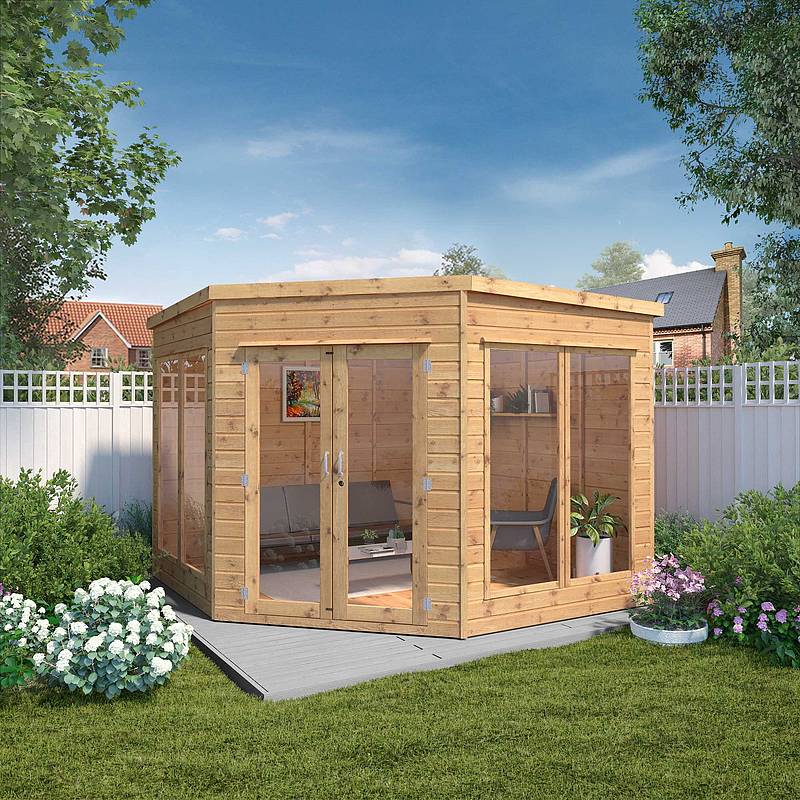
Mercia Garden Corner Summerhouse
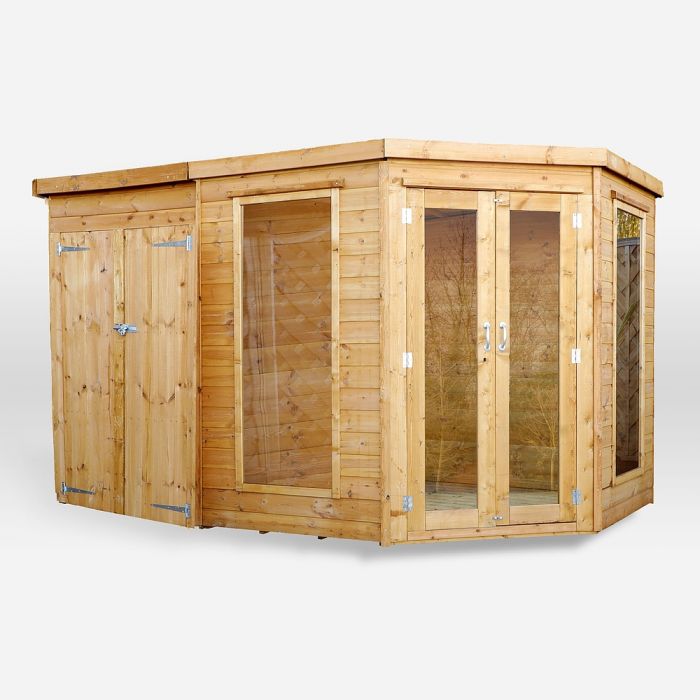
General Instructions
BEFORE YOU START PLEASE READ INSTRUCTIONS CAREFULLY
- Check the pack and make sure you have all the parts listed.
- When you are ready to start, make sure you have the right tools at hand (not supplied) including a Phillips screw-driver, Stanley knife, wood saw, step ladder and drill with 2mm bit.
- Ensure there is plenty of space and a clean dry area for assembly.
TIMBER
As with all natural materials, timber can be affected during various weather conditions. For the duration of heavy or extended periods of rain, swelling of the wood panels may occur. Warping of the wood may also occur during excessive dry spells due to an interior moisture loss. Unfortunately, these processes cannot be avoided but can be helped. It is suggested that the outdoor building is sprayed with water during extended periods of warm sunshine and sheltered as much as possible during rain or snow.
Once your garden building has been installed it will need to be treated as soon as possible and annually to prevent the timber from deteriorating and to waterproof it. This is required to maintain the anti-rot guarantee.Dip Treated buildings – Require a preservative treatment to protect against rot and decay and a waterproof treatment to prevent water ingressPressure Treated buildings – Require a waterproof treatment to prevent water ingressLog Cabins – Are supplied untreated and require a preservative and waterproofing treatment.
BUILDING A BASE
When thinking about where the building and base is going to be constructed:Ensure that there will be access to all sides for maintenance work and annualtreatment.Ensure the base is level and is built on firm ground, to prevent distortion. Refer to diagrams for the base dimensions, The base should be slightly smaller than the external measurement of the building, i.e. The cladding should overlap the base, creating a run off for water. It is also recommended that the floor be at least 25mm above the surrounding ground level to avoid flooding.
TYPES OF BASE
- Concrete 75mm laid on top of 75mm hard-core.
- Slabs laid on 50mm of sharp sand.
Whilst all products manufactured are made to the highest standards of Safety and in the case of children’s products independently tested to EN71 level, we cannot accept responsibility for your safety whilst erecting or using this product.Refer to the instructions pages for you specific product code
- For ease of assembly, you MUST pilot drill all screw holes and ensure all screw heads are countersunk.
- Winter = High Moisture = ExpansionSummer = Low Moisture = Contraction
- CAUTIONEvery effort has been made during the manufacturing process to eliminate the prospect of splinters on rough surfaces of the timber. You are strongly advised to wear gloves when working with or handling rough sawn timber.
**Protim Aquatan T5 (621)**Your building has been treated with Aquatan.Aquatan is a water-based concentrate which is diluted with water, the building as been treated by the correct application of Aquatan solution and then allowed to dry.Aquatan is a decorative finish to colour the wood, which is applied industrially to timber fence panels and garden buildings.Aquatan undiluted contains: boric acid, sodium hydroxide 32% solution, aqueos mixture of sodium dioctyl sulphosuccinat and alcohols: 2, 4, 6-trichlorophenol.
Overall Dimensions:
- Length = 2073mm
- Width = 2073mm
- Height = 2145mm
Base Dimensions:
- Length = 1998mm
- Width = 1998mm
Content Box

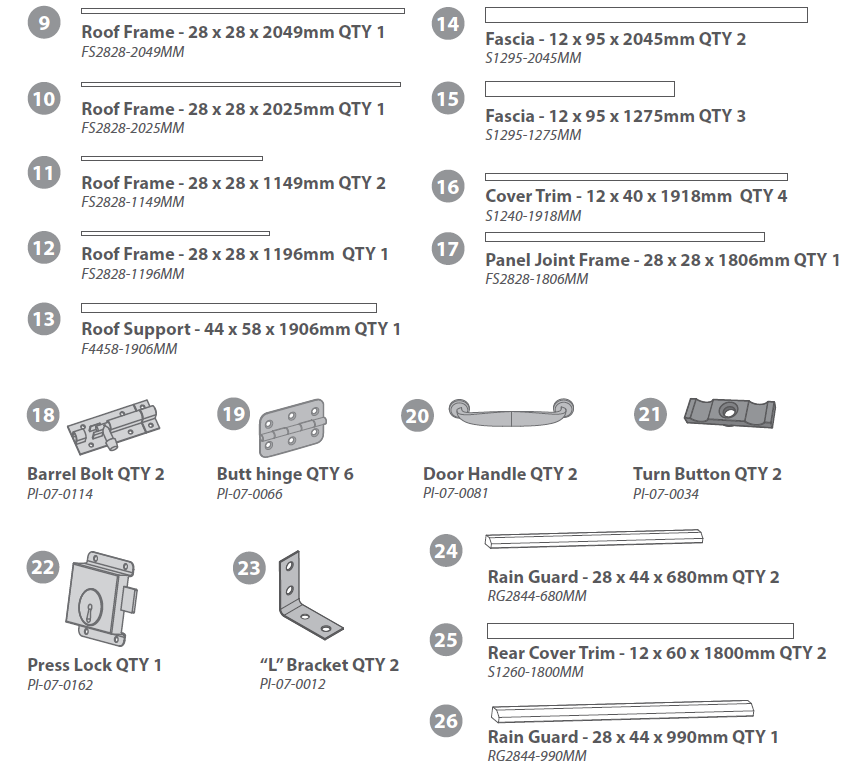
Nail Bag
Pre Assembly
Remove transportation blocks from the bottom of each panel before beginning assembly. Each Panel should have two.Attach the butt hinges to the door using 3x25mm screws and to the door panel using 3x30mm screws per hinge.
Position press lock on the door align with key hole and fix into position using 4 x 10mm screws.
Then fit barrel bolts to top and bottom of the door as shown in diagram. Use 4x10mm screws per barrel bolt. Ensure doors open and close freely.Drill a hole in the framing above and below the door for the tower bolt to fix into.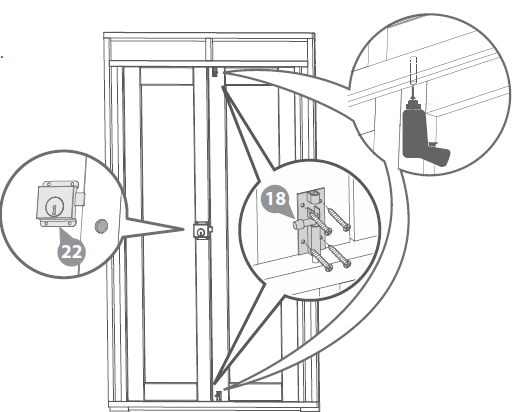
Pre drill holes then fix Chrome Handle using 35mm coach screw as shown in diagram.
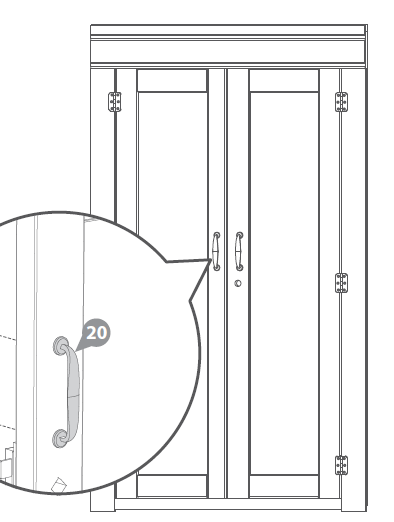
Step 1:
Place the floor on a firm and level base, ensure the base has suitable drainage, free from areas where standing water can collect.
*Wood is a natural product and is subject to movement with changing weather conditions. It is important that you fit the turn buttons and tower bolts as per the fitting instructions.
Step 2:

Fix the window panels and the door panel with 6x60mm screws as shown in the diagram.
Step 3:
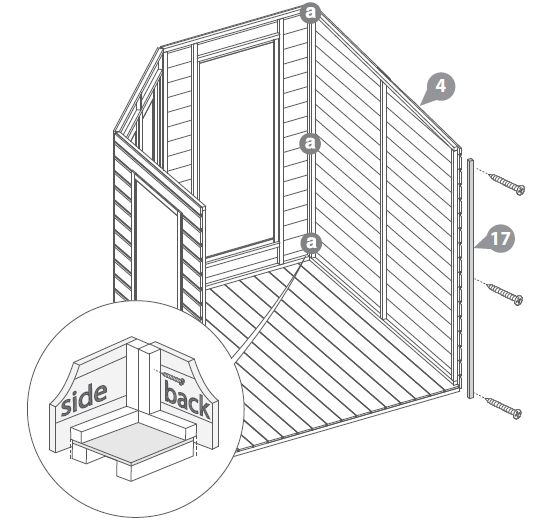
Place rear panel left against the floor and the window side. Fix into place using 3x50mm screws as shown in the diagram.Attach the panel joint into place with 3x50mm screws
Step 4:
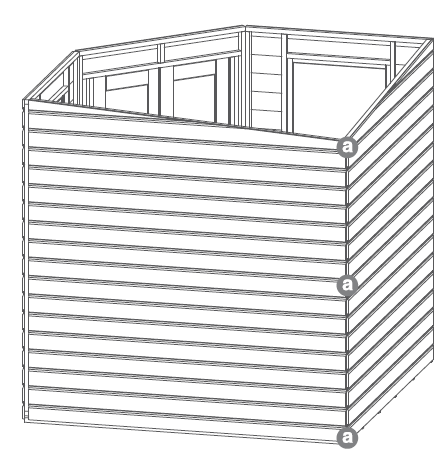
Using the same method outlined in Step 3 place the rear panel right against the floor and window panel securing using 6x50mm screws.
Step 5: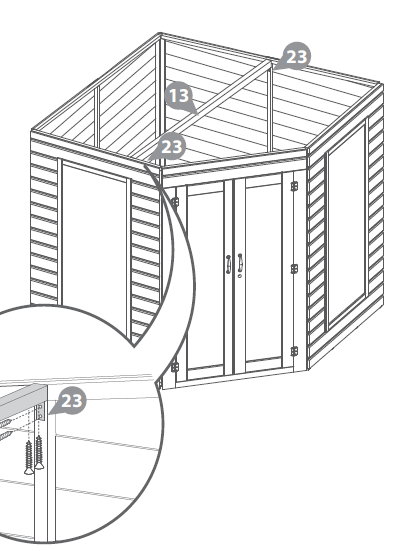
Position the support bar across the building from the left window panel upright framing to the opposite framing on the plain panel right as shown in the diagram.Fix the support bar the framing on both panels using the L bracket and 4x30mm screws per bracket as shown in the bubble diagram.
Step 6:
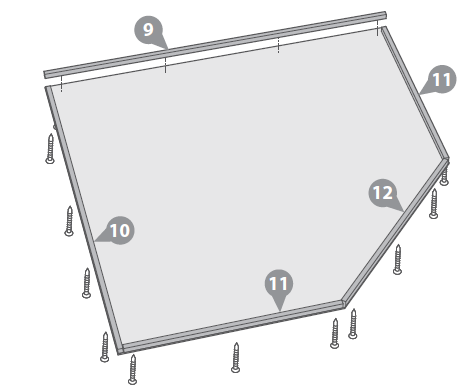
Layout the roof sheet and position the roof framing onto the sheet as shown in the diagram.Ensure the framing is level around the edges and fix into place using 30mm screws.* It is recommended to cut the felt sheets before fixing the roof to the building.
Step 7:

Place the roof section on top of the building, ensure the roof framing slots over each side.Fix the roof onto the panels using 40mm screws making sure they line up with the internal framing.Screw 6x60mm screws through the roof and into the support bar.
Step 8:
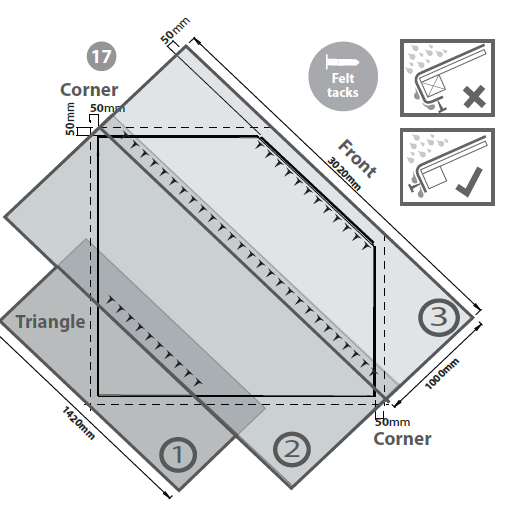
Cut three strips from the roll of felt, 2x3020mm and 1x1420mm in length. Place felt on top of roof sheet and align as shown in diagram ensuring strip 3 over hangs the front by 50mm. with equal spacing at each corner.*Ensure strip 1 is the first piece placed down then lay sheet 2 and then 3. Make sure each sheet overlaps the next by at least 100mm creating a run off.
Use a fascia as a guide to mark out the angled cuts including 50mm overhang.Cut the sides as shown in diagram at the dotted lines, use fascia width as a cutting guide. Cut the triangle with 50mm overhang again using fascia as a guide.
Step 9: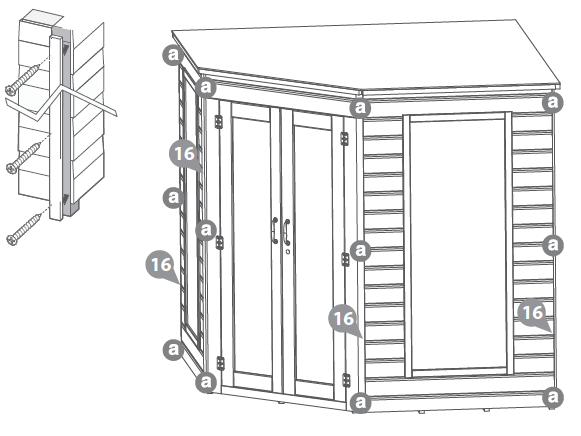
Attach the cover trims as shown using 3x40mm screws per cover trim.
Step 10:
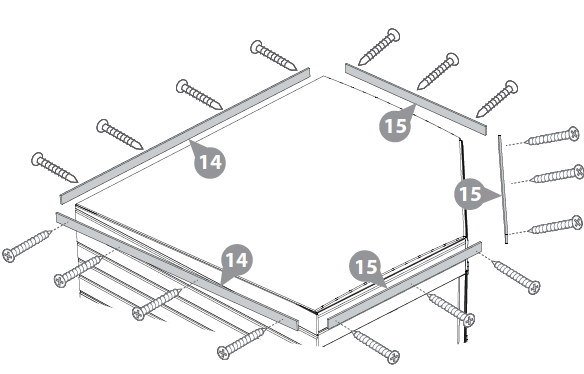
Fit the fascias to the building over the felt and secure in place with 40mm screws as shown. Cut to length where necessary. Pre drill to avoid splitting.Make sure the fascias at the back of the building fit lower than the roof height to allow water to run off.
Step 11:

Attach the two turn buttons to the slave door using 2x16mm screws.* These turn buttons help to keep your doors straight during high and low levels of moisture content in the air.
Step 12:
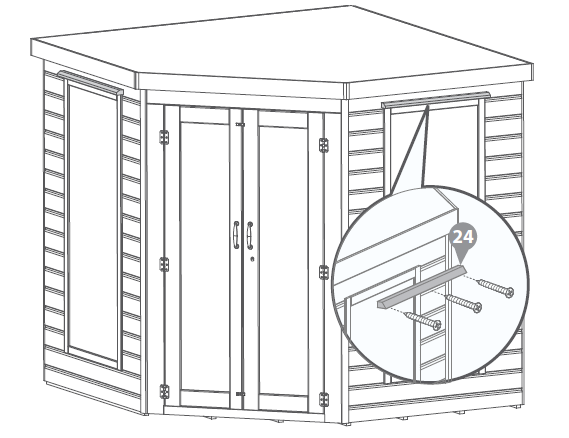
Attach the rain guards to the building, fixing in place above each window using 3x60mm screws per guard.
Step 13: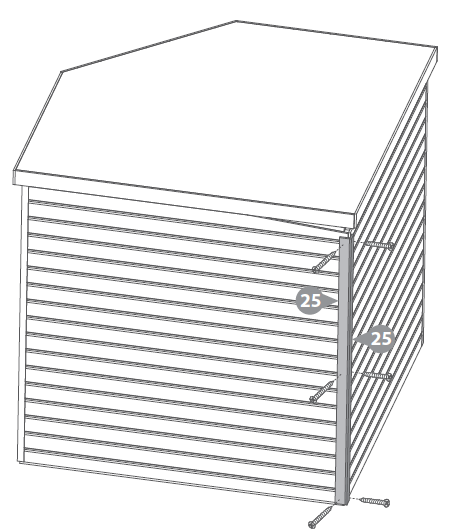
Fix the rear cover trimsto the back of the building, aligning with the edge of the panel.
Step 14:
Attach the larger rain guard above the door, fixing in place using 3x60mm screws.

References
[xyz-ips snippet=”download-snippet”]

